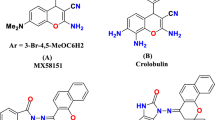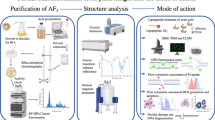Abstract
The heterocyclic analogues of chalcones were synthesized by Claisen Schmidt reaction of (a) benzaldehyde with 2-acetylfurane, 2-acetylpyrrole and 2-acetylthiophene and (b) acetophenone with furfural, thiophene-2-carbaldehyde and pyrrole-2-carbaldehyde. The photolysis of class (a) and (b) chalcones under UV lamp gave different products. The stereoselective photodimerization of 1-(furane-2-yl)-3-phenylprop-2-en-1-one (1), 3-phenyl-1-(1H-pyrrole-2-yl)-prop-2-en-1-one (2) gave β-truxinic type dimers, (3,4-diphenylcyclobutane-1,2-diyl)bis (furane-2-yl methanone) (7), (3,4-diphenylcyclobutane-1,2-diyl)bis ((1H-pyrrol-2-yl) methanone) (8) by syn head-to-head coupling whereas 3-phenyl-1-(thiophen-2-yl)-prop-2-en-1-one (3) gave δ-truxinic type dimers, (3,4-diphenylcyclobutane-1,2-diyl)bis (thiophen-2-yl methanone) (9) by anti head-to-head coupling. The photolytic products of 3-(furane-2-yl)-1-phenylprop-2-en-1-one (4), 1-phenyl-3-(thiophen-2-yl)-prop-2-en-1-one (5) and 1-phenyl-3-(1H-pyrrole-2-yl)- prop-2-en-1-one (6) were identified as corresponding 1,6-di(furane-2-yl)-3,4-diphenylhexa-1,5-diene-3,4-diol (10), 3,4-diphenyl-1,6-di(thiophen-2-yl)hexa-1,5-diene-3,4-diol (11) and 3,4-diphenyl-1,6-di(1H-pyrrol-2-yl)hexa-1,5-diene-3,4-diol (12) pinacol dimers. The antibacterial and antifungal activity of the precursor chalcones and the dimeric products showed antimicrobial activities of different extents with respect to individual compounds. In general, photolysis of heteroaryl chalcones causes the depletion of antimicrobial activity.




Similar content being viewed by others
References
Alexander K, Hafner LS, Smith GH, Schniepp LE (1950) The partial hydrogenation of difurfuralacetone and related compounds. J Am Chem Soc 72:5506–5507
Cesarin-Sobrinho D, Netto-Ferreira J (2002) Fotoquimica de chalconas fluoradas no estado solido. Quim Nova 1:62–68
Cheenpracha S, Karalai C, Ponglimanont C, Shubhadhirasakul S, Tewtrakal S (2006) Anti-HIV-1 protease activity of compounds from Boesenbergia pandurata. Bioorg Med Chem 14:1710–1714
D’Auria M (2001) Photochemical dimerization in solution of heterocyclic substituted alkenes bearing an electron withdrawing group. Heterocycles 54:475
D’Auria M, Racioppi R (1998) Photochemical dimerization of esters of urocanic acid. J Photochem Photobiol A Chem 112:145–148
D’Auria M, Emanucle G, Mauriello R, Racioppi R (2000) Photochemical dimerization of 2-vinylfuran and 2-vinylthiophene derivatives bearing electron-withdrawing groups. J Photochem Photobiol A Chem 134:147–154
D’Auria M, Emanueke L, Esposito V, Racioppi R (2002) The photochemical dimerization of 3-heteroaryl-acrylates. Arkivoc 11:65–78
Domínguez JN, Leon C, Rodrigues J, Domínguez JG, Rosenthal PJ (2005) Synthesis and antimalarial activity of sulfonamide chalcone derivatives. Farmaco 60:307–311
Drew WL, Barry AL, O’Toole R, Sherris JC (1972) Reliability of the Kirby–Bauer disc diffusion method for detecting methicillin-resistant strains of Staphylococcus aureus. Appl Microbiol 24:240–247
Ishikawa T, Koseki N, Furukawa T, Sakurada E, Koseki C, Saito Y, Ogata K, Harayama T, Ishii H (1994) Photochemistry of 2-(3,4,5-trimethoxyphenyl)-4-(3,4-methylenedioxy)-4-oxo-2-butenonitrile (β-cyanochalcone) and its related compounds. Tetrahedron 50(31):9287–9302
Jacob D, Kaul DK (1973) Oestrogenic and antifertility effects of chalcone derivatives. Acta Endocrinol 74:371–378
Katerere RD, Gray IA, Kennedy RA, Nash JR, Waigh DR (2004) Cyclobutanes from Combretum albopunctatum. Phytochemistry 65:433–438
Lin Z, Ming C, Jens B, Thor G, Theander S, Brogger C, Arsalan K (1999) The antileishmanial activity of novel oxygenated chalcones and their mechanism of action. J Antimicrob Chemother 43:793–803
Lubrzynska C (1916) Chalcone and its analogs as agents for the inhibition of angiogenesis and related disease states. J Chem Soc 1118–1120
Matoba K, Yamazakit T (1982) Michael addition of [1H] Pyrrole. Chem Pharm Bull 30(7):2586–2589
Midolo PD, Turnidge J, Lambert JR, Bell JM (1995) Validation of a modified Kirby–Bauer disk diffusion method for Metronidazole susceptibility testing of helicobacter pylori. Diagn Microbiol Infect Dis 21(3):135–140
Nowakowska Z, Wyrzykiewicz E, Kezia B (2001) Synthesis and antimicrobial properties of N-substituted derivatives of (E)-4-azachacones. Farmaco 56:325–329
Opletalova V, Sedivy D (1999) Chalcones and their heterocyclic analogs as potential antifungal chemotherapeutic agents. Ceska Slov Farm 48:252–255
Opletalova V, Ricicarova P, Sedivy D, Meltrova, D, Krivakova J (2000) Chalcones and their heterocyclic analogues as potential medicaments. Folia Pharm Univ Carol 25: 21–33 and references therein
Rajendra K, Saini A, Choudhary S, Yogesh C, Joshi P (2005) Solvent free synthesis of chalcones and their antibacterial activities. E J Chem 02:224–227
Reddy MVB, Su CR, Chiou WF, Liu YN, Chen RYH, Bastow KF, Lee KH, Wu TS (2008) Design, synthesis, and biological evaluation of Mannich bases of heterocyclic chalcone analogs as cytotoxic agents. Bioorg Med Chem 16:7358–7370
Robert EM, Nord FF (1951) Studies on the chemistry of heterocyclics. XVII. Thiophene polyene acids, aldehydes, and ketones. J Org Chem 16(11):1720–1730
Rtishchev NI, Nosova GI, Solovskaya NA, Lukyashina VA, Galaktionova EF, Kudryavtsev VV (2001) Spectral properties and photochemical activity of chalcone derivatives. Russ J Gen Chem 71:1272–1281
Seidel V, Bailleul F, Waterman GP (2000) (Rel)-1β, 2α-di-(2,4-dihydroxy-6-methoxybenzoyl)-3β, 4α-di-(4-methoxyphenyl)-cyclobutane and other flavonoids from the arial parts of Goniothalamus dardneri and Goniothalamus thwaitesii. Phytochemistry 55:439–446
Shakil NA, Singh MK, Kumar J, Sathiyendiran M, Kumar G, Singh MK, Pandey RP, Pandey A, Parmarv VS (2010) Microwave synthesis and antifungal evaluations of some chalcones and their derived diaryl-cyclohexenones. J Environ Sci Health B 45: 524–530 and references therein
Sharma A, Chakravarti B, Gupt MP, Siddiqui JA, Konwar R, Tripathi RP (2010) Synthesis and anti breast cancer activity of biphenyl based chalcones. Bioorg Med Chem 18:4711–4720
Shibata K, Katsuyama I, Matsui M, Muramatsu H (1991) Synthesis of 3-cyano-2-methylpyridines substituted with heteroaromatics. J Heterocycl Chem 28:161–165
Srinivasan B, Johnson TE, Lad R, Xing C (2009) Structure-activity relationship studies of chalcone leading to 3-hydroxy-4,3′,4′,5′-tetramethoxychalcone and its analogues as potent nuclear factor kappaB inhibitors and their anticancer activities. J Med Chem 52:7228–7235
Toda F, Tanaka K, Kato M (1998) Stereoselective photodimerisation of chalcones in the molten state. J Chem Soc Perkin Trans 1:1315–1318
Turowska-Tryk I, Grzesniak K, Trzop E, Zych TJ (2003) Monitoring structural transformations in crystals. Part 4. Monitoring structural changes in crystals of pyridine analogues of chalcones during [2 + 2]-photodimerization and possibilities of the reaction in hydroxyl derivatives. J Solid State Chem 174:459–465
Viana GSB, Bandeira MAM, Matos FJA (2003) Analgesic and anti-inflammatory effects of chalcones isolated from Myracrodruon urundeuva Allemao. Phytomedicine 10:189–195
Yayli N, Ucuncu O, Aydin E, Gok Y, Yasar A, Baltact C, Yildirim N, Kucuk M (2005) Stereoselective photochemistry of heteroaryl chalcones in solution and the antioxidant activities. J Photochem Photobiol A Chem 169:229–234
Acknowledgments
We are thankful to the Head, School of Studies in Chemistry, Vikram University Ujjain for providing facilities. Constructive suggestions from Dr. Manmohan L. Satnami, School of Studies in Chemistry, Pt. Ravishankar Shukla University, Raipur is acknowledged with appreciation. We are thanks to the Head, Institute of Environment Management and Plant Science, Vikram University, Ujjain for providing microorganisms.
Author information
Authors and Affiliations
Corresponding author
Electronic supplementary material
Below is the link to the electronic supplementary material.
Rights and permissions
About this article
Cite this article
Nagwanshi, R., Bakhru, M. & Jain, S. Photodimerization of heteroaryl chalcones: comparative antimicrobial activities of chalcones and their photoproducts. Med Chem Res 21, 1587–1596 (2012). https://doi.org/10.1007/s00044-011-9667-4
Received:
Accepted:
Published:
Issue Date:
DOI: https://doi.org/10.1007/s00044-011-9667-4




